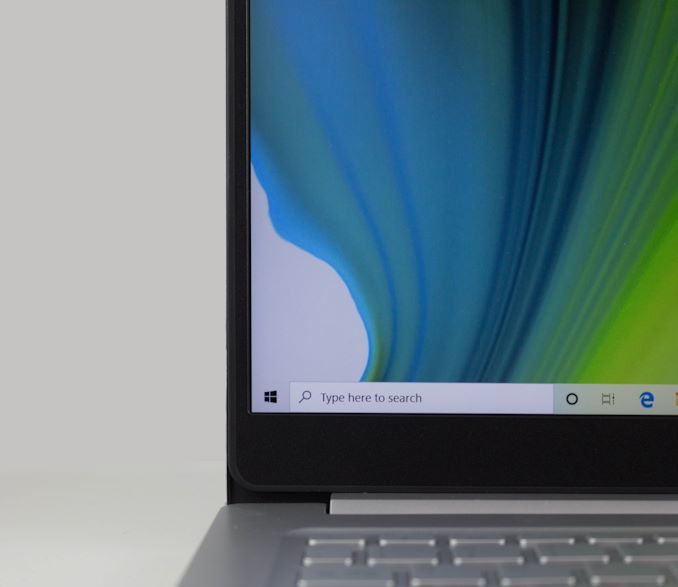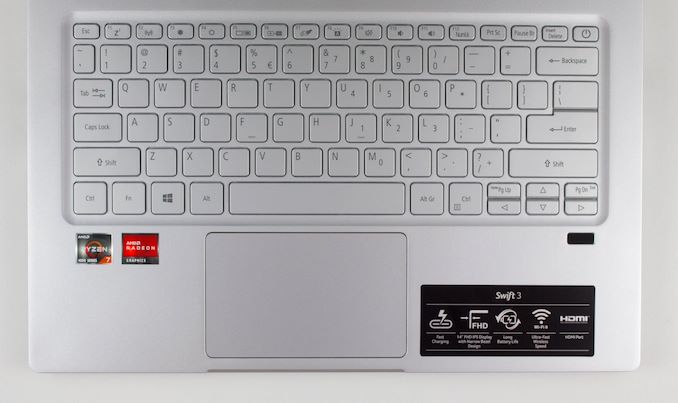The Acer Swift 3 SF314 Notebook Review: Swift Gets Swifter With Ryzen 4000
by Brett Howse & Andrei Frumusanu on May 5, 2020 8:00 AM ESTDesign
Acer’s design ethos for the new Swift 3 would make you think this is a much more expensive device. The 14-inch notebook features an all-aluminum design, offering a much more premium feel than what you’d normally expect on a notebook in this price range. At just 1.2 kg / 2.65 lbs, the 14-inch notebook is extremely portable, and with an 83% screen to body ratio, it is easily as compact as a 13.3-inch notebook from a couple of years ago. Acer’s choice of a 16:9 display does mean that the display has a hefty chin, but is almost certainly a choice that was made to keep the device in-budget.
Despite the thin design and the low price, the aluminum chassis is very stout, with little to no flex no matter how you pick it up. Acer has cut in a slot at the front to make opening the laptop easier, although it will not open with a single finger since the hinge is too stiff to allow this. There is no touch support either, so the hinge stiffness does not need to be quite so tight, but it does make for a solid platform once you open it up.
The keyboard provides a great typing experience. The keys themselves have single-level white backlighting, which works well. The white backlighting on silver keys can cause some contrast issues in bright light, but the effect is not as pronounced as it is on some other devices. Typing offers a surprisingly good keyboard feel, with solid keys that have a solid level of pressure and feedback. Acer has the power button as part of the keyboard, which does make it prone to accidentally turning the device off if you miss the delete key, and moving the power button out of the normal keys would be appreciated, but Acer is far from the only manufacturer to do this, and the laptop resumes instantly so even if it did happen it’s not as big of an issue as it was a few years ago, thanks to the new modern standby options built into Windows and the new CPU.
If there was one area where the notebook showcased it was a lower-cost device, it would be the trackpad. Although it offers the Precision touchpad drivers, the material is not as smooth and responsive as some higher-priced notebooks. This is not so much a knock against the device, but a reality of where it is situated in the market. It does offer the expected multi-touch capabilities you’d expect, it just doesn’t quite offer the level of refinement you’d see in more premium notebooks.
Acer has also included a fingerprint reader, which has great response. It unlocks the device in well under a second even if the display is off. It is a nice to see Windows Hello support despite the lower cost of this device, and the chosen reader seems to work very well. There is no IR camera included, and the built-in webcam is only a 1280x720 unit, so do not expect to be the belle of the Teams meeting, but it gets the job done with a properly located webcam in the top bezel.
Acer offers reasonable I/O as well, with a USB Type-C port on the left, which does support power delivery up to 15 Watts output, and support for charging the device via USB-C as well. There is no Thunderbolt 3, but it does offer DisplayPort output. This is in addition to the included HDMI port, and the laptop also has a USB 3.2 Gen 1 port on the left which supports power-off charging, and a USB 2.0 port on the right, along with a headset jack.
Overall, the Acer Swift 3 is a great design, with a modern feel, and premium materials. The 14-inch notebook is compact, thin, and light, and Acer has done a great job with the look and feel of this device. There are enough ports, and the included USB-C port adds the expanded ability to charge as well as I/O. Looking at this device, you could easily mistake it for a notebook that costs hundreds more.














191 Comments
View All Comments
12345 - Tuesday, May 5, 2020 - link
The dell xps has half the cores and a slightly bigger battery...notb - Wednesday, May 6, 2020 - link
There's a "normalized" comparison with battery capacity impact removed.Don't look at the number of cores. It doesn't matter.
Look at performance:
https://www.anandtech.com/show/15762/the-acer-swif...
Ryzen is faster, but not twice as fast.
Spunjji - Wednesday, May 6, 2020 - link
These aren't relevant to the "normalized" scores. What is relevant is: smaller screen, lower-power screen, platform design optimised over several generations, and that the device costs nearly 3 times as much. You can do a lot more selective component sourcing and rigorous platform optimization for that price difference.Spunjji - Wednesday, May 6, 2020 - link
1) Competing doesn't mean winning, and an improvement that gets AMD to the point of working-day battery life from an inexpensive device is a significant one. It's definitely competing.2) Based on the results in other areas (like sustained frequency) I'm inclined to believe this isn't a particularly well-optimised example of the platform - meanwhile, the Intel hardware it's up against has been well-characterised by the OEMs at this stage. It doesn't matter to a consumer or a buyer of this specific device, but it does affect overall comparisons. The numbers from the Zephyrus G14 are much more positive (although it does use a better bin of the chip).
warisz00r - Tuesday, May 5, 2020 - link
I'd be more than happy to pay $300 - $400 more if it comes with 1) bigger battery 2) double the RAM 3) better display and 4) better cooling but $649 is still a really good deal for those who prioritizes CPU performance.neblogai - Tuesday, May 5, 2020 - link
Check the Lenovo Slim 7. It is a bit more expensive to start with, and weighs 1.4kg, but comes with 100% sRGB Freesync IPS 300Nits+ display, bigger battery, has option for 16GB of RAM (LPDDR4X 4266), and much higher power profiles that allow sustained ~28W APU power.psychobriggsy - Tuesday, May 5, 2020 - link
That looks really nice! And Freesync on an APU powered laptop makes sense as frame rates can dip.ads295 - Tuesday, May 5, 2020 - link
I think Acer look to appeal to a certain class of people that don't want to pay too much for a decent PC and don't really know a lot about them either - I guess that's your typical consumer who doesn't read AnandTech. So all these additions would undoubtedly add value to the notebook but whether the increase in perceived value is enough to justify an increase in price is a matter of risk.Evidently they think it's better to stick to a formula (compact form, good APU, plenty of RAM and SSD storage with decent battery life) to make it a no-brainer of sorts at that price point.
psychobriggsy - Tuesday, May 5, 2020 - link
The price is outstanding for an 8C performance-leading laptop.But yes, if Acer could do a version of this but: (1) 16GB LPDDR4X on board (2) Upgrade the screen quality (or at least offer a screen upgrade or two at online purchase time) (3) better battery option (if space allows).
The screen is the real let down in this device however - which is a shame considering the performance.
Oxford Guy - Thursday, May 7, 2020 - link
Oh, yeah... Throttling the CPU to 8 watts is a recipe for being "performance-leading".